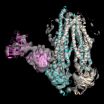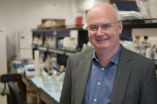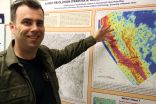(Press-News.org) WEST LAFAYETTE, Ind. – Researchers are close to commercializing a new type of medical imaging technology that could diagnose cardiovascular disease by measuring ultrasound signals from molecules exposed to a fast-pulsing laser.
The system takes precise three-dimensional images of plaques lining arteries and identifies deposits that are likely to rupture and cause heart attacks, said Ji-Xin Cheng (pronounced Jee-Shin), a professor in Purdue University's Weldon School of Biomedical Engineering and Department of Chemistry.
The imaging reveals the presence of carbon-hydrogen bonds making up lipid molecules in arterial plaques that cause heart disease. Research findings are detailed in a paper appearing online today (Nov. 4) in the Nature journal Scientific Reports.
"This allows us to see the exact nature of plaque formation in the walls of arteries so we can define whether plaque is going to rupture," said Michael Sturek, coauthor of the paper and a professor and chair of the Department of Cellular & Integrative Physiology at Indiana University School of Medicine. "Some plaques are more dangerous than others, but one needs to know the chemical makeup of the blood vessel wall to determine which ones are at risk of rupturing."
Research in the area has been hindered by the inability to perform high-speed imaging in tissue. The researchers solved the problem by developing a Raman laser that produces 2,000 pulses per second, each pulse capable of generating an image, representing a 100-fold increase in the imaging speed of the new technology, called intravascular photoacoustic imaging.
"This innovation represents a big step toward advancing this technology to the clinical setting," Cheng said.
The paper was authored by researchers from Purdue, Indiana University School of Medicine, the University of California, Davis, the University of California, Irvine and startup company Spectral Energy.
The imaging technique is "label free," meaning it does not require samples to be marked with dyes, making it appealing for diagnostic applications.
The technology is being commercialized by the company Vibronix Inc., co-founded by Cheng and Purdue postdoctoral research associate Pu Wang.
The laser, which pulses in the near-infrared range of the spectrum, causes tissue to heat and expand locally, generating pressure waves at the ultrasound frequency that can be picked up with a device called a transducer.
The system is small enough to be incorporated into an endoscope to put into blood vessels using a catheter, said Cheng.
The near-infrared laser causes enough heating to generate ultrasound but not enough to damage the tissues. The research was conducted with intact pig tissue and will expand to research with live animals and then clinical studies with humans.
A U.S. patent application has been filed by the Purdue Office of Technology Commercialization.
INFORMATION:
The paper was authored by Wang; USC graduate student Teng Ma; Purdue research scientist Mikhail N. Slipchenko; USC graduate student Shanshan Liang; Purdue graduate student Jie Hui; K. Kirk Shung, director of the Ultrasonic Transducer Resource Center at USC; Sukesh Roy, CEO of Spectral Energy LLC in Dayton, Ohio; Sturek; USC researcher Qifa Zhou; Zhongping Chen, a researcher at UC Irvine: and Cheng.
Funding sources for the research include the National Institutes of Health and the American Heart Association.
Writer: Emil Venere, 765-494-4709, venere@purdue.edu
Sources: Ji-Xin Cheng, 765-494-4335, jcheng@purdue.edu
Michael Sturek, 317-274-7772, msturek@iu.edu
Related websites:
Ji-Xin Cheng: https://engineering.purdue.edu/BME/Research/Labs/Cheng
Weldon School of Biomedical Engineering: http://www.purdue.edu/bme
IMAGE CAPTION:
This image is taken using a new type of medical imaging technology that could diagnose cardiovascular disease by measuring ultrasound signals from molecules exposed to a fast-pulsing laser. The system, called intravascular photoacoustic imaging, takes precise three-dimensional images of plaques lining arteries and identifies deposits that are likely to rupture and cause heart attacks. This cross-sectional view of an artery shows lipids (green) deposited inside the arterial wall Black and white indicate contrast showing the cross-sectional geometry. (Purdue University Weldon School of Biomedical Engineering image/Ji-Xin Cheng)
A publication-quality image is available at http://www.purdue.edu/uns/images/2014/cheng-arteries.jpg
ABSTRACT
High-speed Intravascular Photoacoustic Imaging of Lipid-laden Atherosclerotic Plaque Enabled by a 2-kHz Barium Nitrite Raman Laser
Pu Wang 1,#, Teng Ma2,#, Mikhail N. Slipchenko1,3,#, Shanshan Liang4,5,#, Jie Hui6, K. Kirk Shung2, Sukesh Roy3,*, Michael Sturek7,*, Qifa Zhou2,*, Zhongping Chen4,*, and Ji-Xin Cheng1,*
1Weldon School of Biomedical Engineering, 2School of Mechanical Engineering; 2Department of Biomedical Engineering, NIH Ultrasonic Transducer Resource Center, University of Southern California, Los Angeles; 3Spectral Energy, LLC, Dayton, Ohio; 4Department of Biomedical Engineering, University of California, Irvine; 5Beckman Laser Institute, University of California, Irvine and Edwards Lifesciences Center for Advanced Cardiovascular Technology; 6Physics Department, Purdue University; 7 Department of Cellular & Integrative Physiology, Indiana University School of Medicine
*To whom correspondence should be addressed. E-mail:jcheng@purdue.edu
Lipid deposition inside the arterial wall is a key indicator of plaque vulnerability. An intravascular photoacoustic (IVPA) catheter is considered a promising device for quantifying the amount of lipid inside the arterial wall. Thus far, IVPA systems suffered from slow imaging speed (~50 s per frame) due to the lack of a suitable laser source for high-speed excitation of molecular overtone vibrations. Here, we report an improvement in IVPA imaging speed by two orders of magnitude, to 1.0 s per frame, enabled by a custom-built, 2-kHz master oscillator power amplifier (MOPA)-pumped, barium nitrite [Ba(NO3)2] Raman laser. This advancement narrows the gap in translating the IVPA technology to the clinical setting.
Note to Journalists: An electronic copy of the research paper is available by contacting Nature at press@nature.com, 212 726 9231.
High-speed 'label-free' imaging could reveal dangerous plaques
2014-11-04
ELSE PRESS RELEASES FROM THIS DATE:
Hot flushes are going unrecognized, leaving women vulnerable
2014-11-04
Hot flushes are one of the most distressing conditions faced by women who have been treated for breast cancer, but they are not being adequately addressed by healthcare professionals and some women consider giving up their post cancer medication to try and stop them, a new study has shown.
More than 70 per cent of women who have had breast cancer experience menopausal problems, and hot flushes in particular, which are among the most prevalent and potentially distressing problems following breast cancer treatment. These can also be long lasting, persisting for more than ...
How cells defend themselves against antibiotics and cytostatic agents
2014-11-04
This news release is available in German.
"On the one hand, ABC transporters causes diseases such as cystic fibrosis, while on the other hand they are responsible for the immune system recognising infected cells or cancer cells," explains Professor Robert Tampé from the Institute for Biochemistry at the Goethe University. The considerable medical, industrial and economic significance of ABC transporters is also based on the fact that they cause bacteria and other pathogens to become resistant to antibiotics. Likewise, they can help cancer cells to defend themselves ...
The inside story: How the brain and skull stay together
2014-11-04
CORAL GABLES, Fla. (November 4, 2014) — Think about the way our bodies are assembled during early development and ask: How do neighboring cells know that they are supposed to become a nerve or a bone cell and how do these tissues find the correct place and alignment? Researchers at the University of Miami (UM) are answering these crucial questions.
In a new study, UM researchers describe the signaling systems that tissues use to communicate with their surrounding neighbors, at the head-trunk region. Their discovery may have important implications for the treatment ...
Preventing postpartum hemorrhage
2014-11-04
Sublingual misoprostol is inferior to intramuscular oxytocin for the prevention of postpartum hemorrhage (PPH) in women undergoing uncomplicated birth at a regional hospital in Uganda, according to trial results published in PLOS Medicine. The randomized non-inferiority trial, conducted by Esther Cathyln Atukunda at the Mbarara University of Science and Technology, Uganda, and colleagues, showed that PPH incidence in the misoprostol arm exceeded that in the oxytocin arm by 11.2% (95% confidence interval 6.44%-16.1%).
PPH is responsible for 25–30% of maternal deaths. ...
Adenotonsillectomy and childhood asthma
2014-11-04
In an analysis of the 2003–2010 MarketScan US database, Rakesh Bhattacharjee and coauthors (University of Chicago, Chicago, Illinois) compared hospital admissions and prescriptions for children with asthma who underwent adenotonsillectomy before and after surgery to determine whether their asthma control improved (based on ICD-9-CM and CPT codes, as well as drug prescriptions) in the year after compared with the year before surgery. They also compared the children with children with asthma who did not undergo adenotonsillectomy who were the same age and sex and lived ...
Surgery for sleep apnea improves asthma control
2014-11-04
Surgical removal of the tonsils and adenoids in children suffering from sleep apnea is associated with decreased asthma severity, according to the first large study of the connection, published in the journal PLOS Medicine.
Researchers from the University of Chicago found that in the first year after the operation, children who had the surgery had a 30 percent reduction in acute asthma exacerbations and a 38 percent decrease in acute status asthmaticus—a medical emergency.
They also found pediatric patients who received the surgery had a 36 percent reduction ...
Genetic damage caused by asthma shows up in circulating blood stream, too
2014-11-04
Asthma may be more harmful than was previously thought, according to UCLA researchers who found that genetic damage is present in circulating, or peripheral, blood. Doctors previously thought that the genetic damage it caused was limited to the lungs.
In the study, researchers looked for the overexpression of a cytokine called interleukin 13 (IL-13), which is known to mediate inflammation, a critical problem for people with asthma.
The study, which was conducted in an animal model that mimicked human asthma, was the first to assess the role of IL-13 in genetic damage ...
Study shows tectonic plates not rigid, deform horizontally in cooling process
2014-11-04
RENO, Nev. – The puzzle pieces of tectonic plates that make up the outer layer of the earth are not rigid and don't fit together as nicely as we were taught in high school.
A study published in the journal Geology by Corné Kreemer, an associate professor at the University of Nevada, Reno, and his colleague Richard Gordon of Rice University, quantifies deformation of the Pacific plate and challenges the central approximation of the plate tectonic paradigm that plates are rigid.
Using large-scale numerical modeling as well as GPS velocities from the largest ...
Disorder + disorder = more disorder?
2014-11-04
WASHINGTON, D.C., November 4, 2014--If you took the junk from the back of your closet and combined it with the dirty laundry already on your floor, you would have an even bigger mess. While this principle will likely always hold true for our bedrooms, it turns out that in certain situations, combining messes can actually reduce the disorder of the whole. An international team of researchers from Slovenia and Iran has identified a set of conditions in which adding disorder to a system makes it more orderly. This behavior is known as antifragility, a concept introduced recently ...
Fast food marketing for children disproportionately affects certain communities
2014-11-04
A newly published research study examining only marketing directed at children on the interior and exterior of fast food restaurants has found that the majority of black, middle-income and rural communities are disproportionately exposed to such marketing tactics.
Authored by Arizona State University researcher Punam Ohri-Vachaspati and her colleagues, the study is the first to examine the use of child-directed marketing on the interior and exterior of fast food restaurants and its relationship to demographics. It adds to a substantial body of literature on the effects ...




